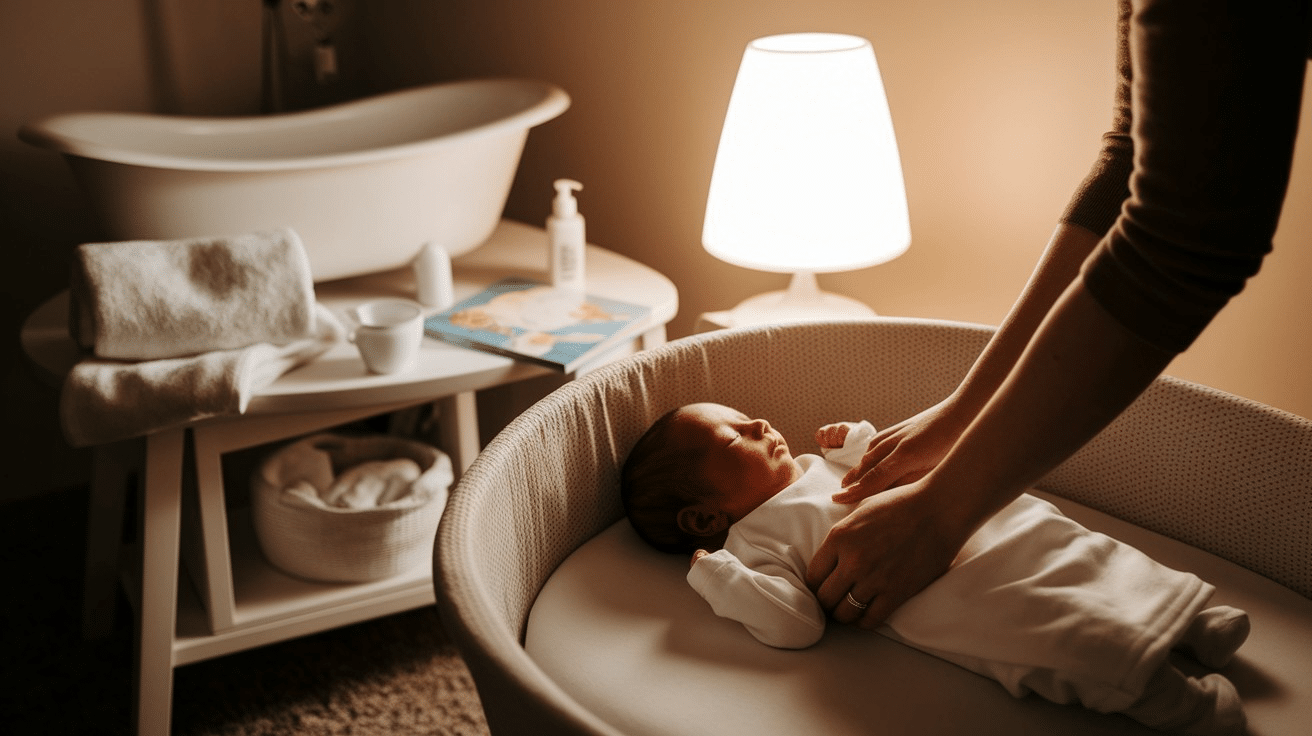
Every parent knows this scene: your baby sleeps blissfully in your arms, but the moment they touch the bassinet—instant wakeup! This frustrating cycle leaves you drained and frantic for solutions.
Why does this happen? It’s actually perfectly natural. Your little one spent months cradled in your warm body, lulled by your heartbeat and comforting movements. The cool, still bassinet feels nothing like the cozy environment they’ve known since conception.
The good news? This challenging pattern can be broken. With the right approaches, you can help your baby transition to independent sleep while keeping them safe and secure. Better rest is possible—for both of you!
Ready to solve the bedtime battle? Join us as we explore proven techniques from parents who’ve cracked the ‘put down puzzle’ and found ways for everyone in the family to get the restful sleep they need.”
Why Are Bassinets Important?
Bassinets provide a safe sleep space for newborns during their first months. These small, portable beds are designed with infant safety as the priority, featuring breathable sides and firm mattresses to reduce SIDS risk.
Their compact size mimics the womb’s snug environment, helping ease the transition to the outside world. The raised height prevents parents from bending too low, reducing back strain during nighttime checks and feedings.
Another key benefit is portability, which allows babies to nap near their parents throughout the day. This proximity enables monitoring while promoting independent sleep habits.
Most bassinets accommodate babies until they can roll over (around 4-6 months), making them a practical first sleep solution before transitioning to a crib.
Despite their temporary use, bassinets remain essential for establishing safe sleep practices during a newborn’s vulnerable early stage.
Common Reasons Newborns Resist Bassinet Sleep

Newborns often prefer being held rather than sleeping in a bassinet. This resistance stems from the stark difference between the warm, snug womb and the open bassinet.
Some babies feel exposed or cold. Others miss the constant movement and heartbeat they experienced before birth.
Temperature changes, digestive discomfort, or startle reflexes can also wake babies who initially fall asleep in arms but wake when placed down.
Physical Comfort Issues
Temperature plays a huge role in a baby’s comfort. If it’s too hot or cold, the baby will fuss.
- Use sleep sacks that match your room temperature
- Dress baby in one more layer than you’re comfortable in
- Check their neck (not hands) to see if they’re sweaty or cool
Lying flat can hurt babies with reflux. The burning feels worse when they’re horizontal. If your baby arches their back, cries during or after feeding, or spits up often, talk to your doctor about reflux.
Missing the Womb Experience
Babies love the security of arms holding them tight. Your heartbeat, warmth, and smell create a safe space they don’t want to leave.
Parent Hack: Try warming the bassinet sheet with a heating pad before putting baby down (remove the pad first!). The warmth feels like your body heat.
The Moro reflex causes babies to suddenly throw out their arms and legs when they feel like they’re falling. This natural reflex can wake them as they start to sleep.
Sleep Timing Challenges
When babies get too tired, their bodies release stress hormones that make it harder to fall asleep. It sounds backward, but an overtired baby sleeps worse than a well-rested one. Watch for early signs like:
- Yawning
- Eye rubbing
- Looking away
Environmental Sensitivity
Some babies need background noise to sleep well, while others need quiet. Finding what works for your baby may take some testing. White noise machines can block sudden sounds that might startle a baby awake.
Strategies to Get Your Baby to Sleep in a Bassinet

Warm the bassinet with a heating pad before placing your baby down (removing it first). Maintain physical contact until your baby enters deep sleep before transferring.
Try the “down-up-down” method—if your baby stirs, pick it up again until settled. Keep the bassinet nearby for nighttime feeds.
Use white noise machines to mimic womb sounds. Consider motion-activated bassinets for babies who need movement.
Optimize Baby’s Environment
Keep your baby’s room between 68-72°F (20-22°C) for good sleep.
- Too hot increases SIDS risk
- Too cold makes baby uncomfortable
- Use a room thermometer for accuracy
- Feel baby’s neck or tummy—it should be warm, not hot or cold
Babies don’t need complete silence to sleep well. Some background noise can help. Use white noise that sounds like a soft shower to block sudden noises.
Wait, did you know? Babies in the womb aren’t used to silence! The constant whooshing of your blood sounds like a vacuum cleaner to them.
Watch Sleep Timing and Alerts
Newborns can only handle being awake for 45-60 minutes at a time. Put your baby down for sleep before they gets cranky.
Watch for your baby’s sleepy signs:
- Yawning
- Rubbing eyes
- Turning away
- Fussing
These tell you it’s time for sleep before overtiredness kicks in.
Parent Hack: Keep a simple log of when your baby seems sleepy for a few days. Patterns will help you predict the perfect put-down time.
Comfort Techniques That Work
The 5 S’s method works magic for many babies:
- Swaddle
- Side-position (only while holding)
- Shush
- Swing
- Suck
Do these before placing the baby in the bassinet.
Develop Healthy Sleep Habits
Put your baby down drowsy but not fully asleep. This helps them learn to fall asleep in their bassinet instead of your arms.
For babies with reflux:
- Raise the head of the bassinet slightly (ask your doctor first)
- Keep baby upright for 20-30 minutes after feeding
- Try smaller, more frequent feedings
Establishing a Pre-Sleep Routine

Create consistent strings that signal sleep time. Give your baby a warm bath followed by a gentle massage with baby-safe lotion. Dim the lights and speak in hushed tones.
Read a short book or sing a soft lullaby. Feed your baby in a calm environment. Repeat these steps in the same order each night. Babies thrive on predictability, and they’ll gradually associate these activities with sleep.
Developing a Soothing Bedtime Routine
Create a simple routine with 3-4 calm activities like:
- A warm bath
- Gentle massage
- Quiet story
- Soft lullaby
Keep the routine under 30 minutes for newborns, and do these same steps in the same order every night:
- Dim lights during routine
- Keep activities calm and voices soft
- Be consistent with timing when possible
Gradual Transition Techniques
Start with daytime naps in the bassinet when sleep pressure is lower.
Try the “pick-up/put-down” method: Soothe the baby until calm, put it down, and pick it up again if it cries. It takes patience, but it teaches the baby that the bassinet is safe.
Parent Hack: Try the “pause” technique—wait 60 seconds before responding to minor fussing. Babies often make noises in their sleep and may settle without help.
Importance of Bassinet Sleep for Safety

Bassinets provide a firm, flat surface that reduces suffocation risks. Their high sides prevent falls as babies become more mobile. Unlike adult beds, bassinets lack soft bedding that could cover a baby’s face.
The American Academy of Pediatrics recommends room-sharing with your baby in a bassinet for at least six months to reduce SIDS risk by up to 50%. This arrangement allows quick response to feeding needs.
Safe Sleep Guidelines
Always place baby on their back on a firm, flat surface with:
- No pillows
- No blankets
- No stuffed animals
- No crib bumpers
These simple rules reduce SIDS risk and keep your baby safe.
Why Bassinet Sleep is Crucial
Bassinet sleep is crucial in the early months because it provides a safe, snug, and supervised environment that supports newborn sleep patterns.
Its compact design promotes better sleep quality while reducing the risk of SIDS by keeping the baby close but in a separate sleep space.
Responding to Crying and Discomfort

Check basic needs first—hunger, diaper, temperature. Try gentle patting or shushing without removing your baby from the bassinet. Place your hand on their chest to provide reassurance.
If the crying continues, pick up your baby until calm, then try again. Watch for signs of reflux or gas, which may require holding upright after feeds. Trust your instincts about when your baby needs comfort versus when they might self-soothe.
Building Trust Through Prompt Response
Check on your crying baby to rule out:
- Hunger
- Wet diaper
- Discomfort
Prompt responses don’t spoil babies—they build security. A secure baby is more likely to accept the bassinet.
Providing Gentle Reassurance
You can reassure your baby without picking them up by:
- Placing a hand on their chest
- Shushing gently
- Patting rhythmically
These touches let them know you’re there without disrupting their settling.
Summing It Up
Remember that helping your baby sleep in their bassinet is a process, not an overnight fix. Some strategies may work better than others for your unique little one. Be patient with yourself and your baby as you find what works best.
The midnight bassinet struggle is tough, but it won’t last forever. With consistent routines, gradual transitions, and plenty of love, your baby will eventually feel secure sleeping independently. And when they do, you’ll both enjoy better sleep and a stronger bond.
Don’t hesitate to seek help from your pediatrician or a sleep consultant if you’re feeling overwhelmed. Taking care of yourself is just as important as taking care of your baby.
After all, a rested parent is better equipped to handle the beautiful chaos of raising a child. Sweet dreams are ahead for both you and your baby!
If you’re interested in more informational content on mothers and babies, feel free to click here and explore other blogs that you might enjoy.
